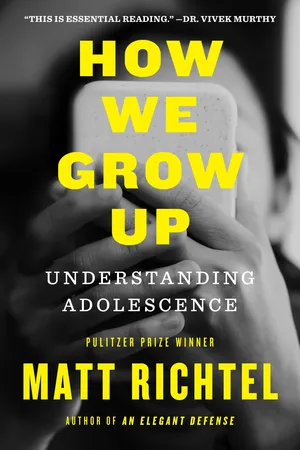
- 400 pages
- English
- ePUB (mobile friendly)
- Available on iOS & Android
About this book
"This is essential reading for parents." — Dr. Vivek Murthy, former U.S. Surgeon General
Greatly expanding his award-winning New York Times series on the contemporary teen mental-health crisis, Pulitzer Prize–winning science reporter Matt Richtel delivers a groundbreaking investigation into adolescence, the pivotal life stage undergoing profound—and often confounding—transformation.
One of The New Yorker's Best Books of 2025
The transition from childhood to adulthood is a natural, evolution-honed cycle that now faces radical change and challenge. The adolescent brain, sculpted for this transition over eons of evolution, confronts a modern world that creates so much social pressure as to regularly exceed the capacities of the evolving mind. The problem comes as a bombardment of screen-based information pelts the brain just as adolescence is undergoing a second key change: puberty is hitting earlier. The result is a neurological mismatch between an ultra-potent environment and a still-maturing brain that can lead to anxiety, depression, and other mental health challenges. It is a crisis that is part of modern life but can only be truly grasped through a broad, grounded lens of the biology of adolescence itself. Through this lens, Richtel shows us how adolescents can understand themselves, and parents and educators can better help.
For decades, this transition to adulthood has been defined by hormonal shifts that trigger the onset of puberty. But Richtel takes us where science now understands so much of the action is: the brain. A growing body of research that looks for the first time into budding adult neurobiology explains with untold clarity the emergence of the “social brain,” a craving for peer connection, and how the behaviors that follow pave the way for economic and social survival. This period necessarily involves testing—as the adolescent brain is programmed from birth to take risks and explore themselves and their environment—so that they may be able to thrive as they leave the insulated care of childhood.
Richtel, diving deeply into new research and gripping personal stories, offers accessible, scientifically grounded answers to the most pressing questions about generational change. What explains adolescent behaviors, risk-taking, reward-seeking, and the ongoing mental health crisis? How does adolescence shape the future of the species? What is the nature of adolescence itself?
Frequently asked questions
- Essential is ideal for learners and professionals who enjoy exploring a wide range of subjects. Access the Essential Library with 800,000+ trusted titles and best-sellers across business, personal growth, and the humanities. Includes unlimited reading time and Standard Read Aloud voice.
- Complete: Perfect for advanced learners and researchers needing full, unrestricted access. Unlock 1.4M+ books across hundreds of subjects, including academic and specialized titles. The Complete Plan also includes advanced features like Premium Read Aloud and Research Assistant.
Please note we cannot support devices running on iOS 13 and Android 7 or earlier. Learn more about using the app.
Information
Table of contents
- Cover
- Title Page
- Dedication
- Contents
- Author’s Note
- Part I: Castaways
- Chapter 1: The Baton
- Chapter 2: Thomas
- Part II: The Infancy and Childhood of Adolescent Science
- Chapter 3: ad·o·les·cent
- Chapter 4: Bones
- Chapter 5: The Sorrows of Young Werther
- Chapter 6: The Man Who Put Adolescence on the Map
- Chapter 7: Erikson and Anna Freud
- Chapter 8: Sheep Brains, Puberty, and the Night Highway
- Chapter 9: Crossing Over
- Chapter 10: Upstairs Puberty
- Chapter 11: Internet Brain
- Part III: Meet the Future
- Chapter 12: Darron
- Chapter 13: Luke and Henry
- Chapter 14: Lindsey
- Chapter 15: Anna and Thomas
- Chapter 16: Deadname
- Chapter 17: Generation Rumination
- Part IV: The Maturation of Adolescent Science
- Chapter 18: Peebudieshawlt
- Chapter 19: Risk and Reward
- Chapter 20: GABA and Glutamate and Dopamine
- Chapter 21: Facetime
- Chapter 22: The Dual Systems Model
- Chapter 23: Puberty Falls
- Chapter 24: Permissive Signals
- Chapter 25: The Gambia and the Zambia
- Part V: A Hero’s Journey
- Chapter 26: Darron
- Chapter 27: Luke and Henry
- Chapter 28: Lindsey
- Chapter 29: Thomas
- Part VI: The World We Live In: Opportunity and Chaos
- Chapter 30: Social Media
- Chapter 31: The Displacement Effect
- Chapter 32: Neurological Mismatch
- Chapter 33: Hey, Adolescents, Own Your Own #*^& (or These People Will)
- Chapter 34: Dear Technology Companies
- Chapter 35: Zombies and Other Phantom Fears
- Chapter 36: How to Cope with Chaos
- Chapter 37: The Most Valuable Generation (by the Numbers)
- Chapter 38: And Now a Word from Elvis (the Movie) and the Supreme Court
- Part VII: Homeward Bound
- Chapter 39: Darron
- Chapter 40: Lindsey
- Chapter 41: Luke
- Chapter 42: Henry
- Chapter 43: Thomas
- Chapter 44: Courtney
- Chapter 45: The Adolescent
- Acknowledgments
- Index
- About the Author
- About Mariner Books
- Also by Matt Richtel
- Copyright
- About the Publisher